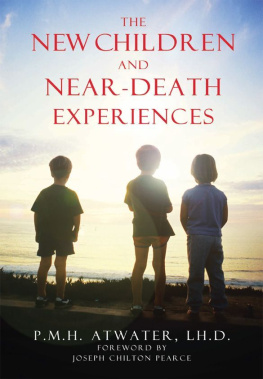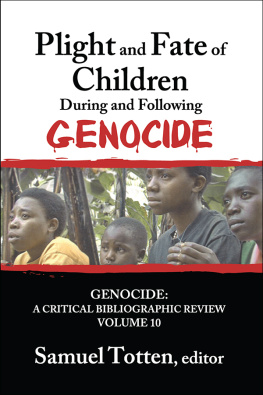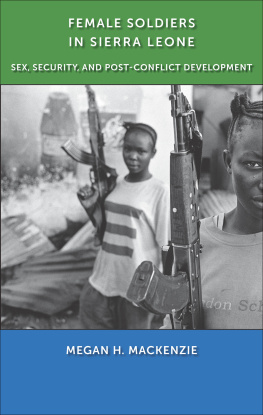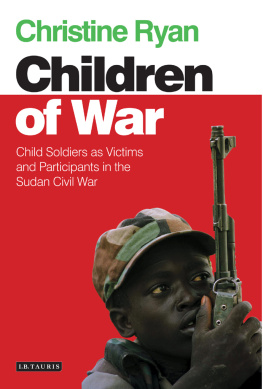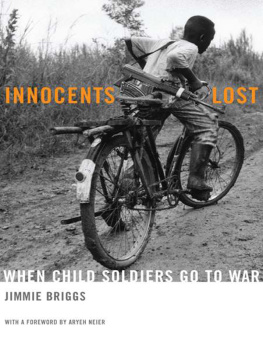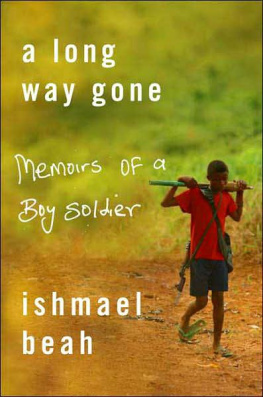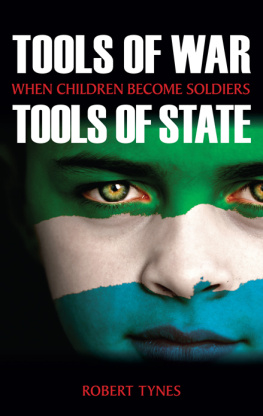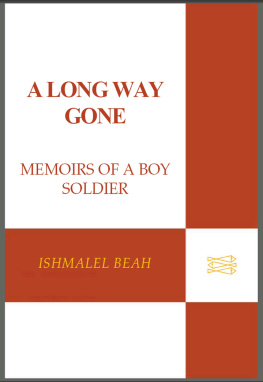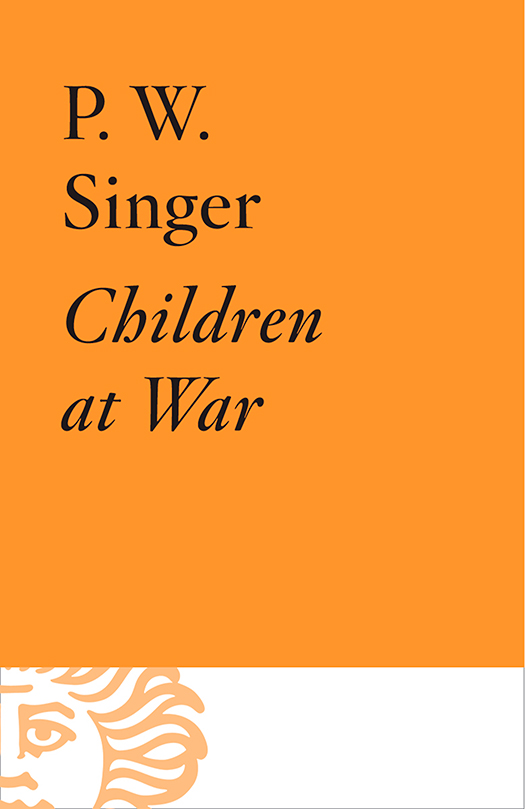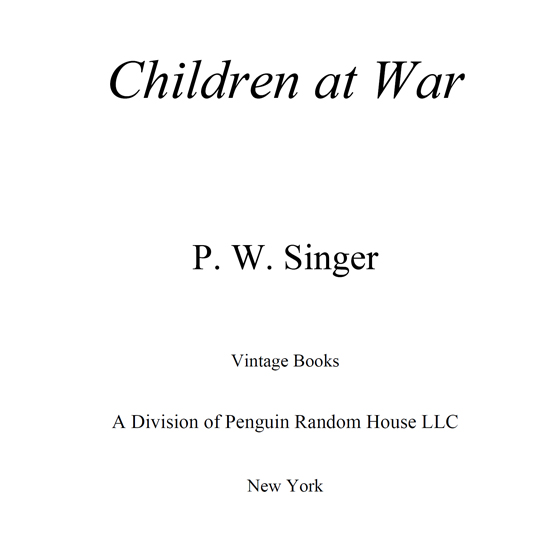ALSO BY P. W. SINGER
Corporate Warriors:
The Rise of the Privatized Military Industry
FIRST VINTAGE EBOOKS EDITION, MARCH 2015
Copyright 2005 Peter Warren Singer
All rights reserved. Published in the United States by Vintage Books, a division of Penguin Random House LLC, New York. Originally published in hardcover in the United States by Pantheon Books, a division of Penguin Random House LLC, New York, in 2005. Vintage and colophon are registered trademarks of Penguin Random House LLC.
The Library of Congress has cataloged the Pantheon edition as follows:
Singer, P. W. (Peter Warren)
Children at war / P. W. Singer.
p. cm.
1. Child soldiersHistory20th century. 2. Child SoldiersHistory21st century. I. Title.
UB416.S56 2005 355.0083dc22 2004053448
eBook ISBN: 978-1-101-97005-8
www.vintagebooks.com
v3.1_r1
When one has no one left on the earth, neither father nor mother, neither brother nor sister, and when one is small, a little boy in a damned and barbaric country where everyone slashes each others throats, what does one do? Of course, one becomes a child soldier, a small soldier, to get ones fair share of eating and butchering as well. Only that remains.
A HMADOU K OUROUMA , Allah nest pas oblig
CONTENTS
AUTHORS NOTE
Over the course of researching and writing this book, I have been asked many times why I would ever want to write about a topic so shocking and disheartening as child soldiers.
The vast changes in warfare that we are witnessing in the twenty-first century, most particularly the rise of new conflict groups, have long interested me. While we commonly think of war as men in uniform, fighting for the political causes of their states, it is not the case. The wars of our times are actually fought by men, women, and now children. Their causes are often political, but they also fight for economic, social, religious, or even criminal motives. The groups that they fight within can be anything from a state army or a terrorist cell to a warlords gang or a drug cartels paramilitaries.
I first became interested in child soldiers through my prior study, Corporate Warriors, which looks at another new participant in warprivate businessesthat now carry out the jobs that soldiers used to perform. As these new soldiers of the private market discussed their experiences, I was amazed to learn that their adversaries in combat repeatedly included young children. I quickly discovered that this was a growing and global phenomenon, but one that few analysts, policymakers, or even soldiers in Western militaries were aware of.
Little was understood of the issue, not only where, why, and how the practice of using children in war came about, but also what it means and, most importantly, what to do about it. An international alliance of nongovernmental organizations, the Coalition to Stop the Use of Child Soldiers, has emerged to bring attention to the issue, and passing media coverage has been paid to isolated cases of child soldiers (which tend to find their way into the press mainly because of heartrending photos, such as the broadly carried image of the cigar-smoking Htoo brothers, two child soldiers from Myanmar). But the overall issue of child soldiers was and still is a largely invisible one to both researchers and policymakers. For example, among those political scientists who study modern-day world politics and warfare, the treatment of the phenomenon is at best peripheral. It has either focused on the specific conflicts in which child soldiers were present or on issues that are indirectly linked, such as the small arms trade. The existing scholarship of psychologists, historians, and sociologists who study behavior in war all generally ignores the issue.
This is not just a problem for academia, but is a problem that has clear policy implications that should concern us all. Until we understand the nature of the problem and what to do about it, we can, at best, only express how terrible and tragic it is. At worst, we will develop responses that are either lacking or even counterproductive. Many of the noble-minded political and advocacy efforts designed to end the use of child soldiers are often not connected to the real underlying causes and, for all their energy and good intent, have been largely ineffective. In the military and intelligence realm, little awareness and no counter to the phenomenon has been developed despite childrens general presence in contemporary warfare. Our soldiers must deal with the complex dilemmas of facing children on the battlefield without proper intelligence warnings or training to help prepare or guide them. In the humanitarian realm, the repeated failure to appreciate the unique risks and problems of child soldiers has repeatedly crippled demobilization and rehabilitation efforts once the wars are over. We cannot even begin to think that we have a handle on what to do about the dynamics of present-day armed conflict until we have a better understanding of the role children play in it.
The topic of children at war is admittedly not an easy one, neither to research nor to read about. These new soldiers are not simply children; they can also be callous killers capable of the most terrible acts of cruelty and brutality. Many are adrift, having lost their entire families, including some by their own hands; they may know nothing except a world of violence. At the same time, they are still children whom society has an obligation to protect. Their understanding of the power and consequences of their acts is often limited. Indeed, childrens immaturity and inexperience is often the very reason they are exploited. It is this innocence of youth placed within the context of war that is perhaps the most difficult to deal with.
To accomplish the research for this book, I relied on an extensive body of primary and secondary literature from a number of disparate fields, including psychiatry, pediatric medicine, anthropology, military history, sociology, and political science. The biggest challenge was not the creation of new knowledge, but rather discerning and integrating what was already known across many different areas into a more focused and useful understanding. As such, the work reflects the hard work of many before me, including the reporting of countless aid and rehabilitation workers who collected this data and gained this experience. They are to be applauded for their dedication and, most of all, their humanity.
Most importantly, though, this book would not have been possible without the assistance of those who consented to speak with me about their experiences. They ranged from former child soldiers who fought in a number of conflicts (including in Colombia, Lebanon, Liberia, Kashmir, Kosovo, Sierra Leone, Sri Lanka, and Sudan), to aid and humanitarian workers around the globe, to many of the individual soldiers, both public and private, who have been put in the terrible position of having to fight children. Where quotes are used, they are most often from sources already in the public domain or who use pseudonyms. This reflects my rather unique starting point in the secretive private military industry, but also addresses a broader concern I had throughout the process of writing this book. I preserve the anonymity of interviewees both as a means to maintaining future access and a way of encouraging a greater frankness of discussions. It also stays within what I believe are my proper bounds as a political science analyst trained neither as a counselor nor health practitioner. The cooperation and willingness of all to speak with me is deeply appreciated.


